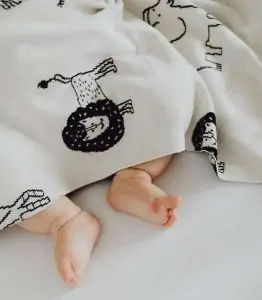Maternity ward nurses are more than heroes. They’re wizards with a receiving blanket, capable of wrapping it perfectly around your brand new little one.
In America, it seems everyone gets this same blanket from Medline. The design has been around since the 1950s…you know the one with that same stripe down the middle. In China, they had a different one that was a bit puffier, but the same thing happened. Everyone I knew that had a baby in China had the same receiving blanket.
And, of course, everyone will give you gobs of receiving blankets. So you’ll have no shortage of them. I wrote about swaddling blankets and receiving blankets recently, so you can go have a look there and see what you can do with them when the baby outgrows them.
If you’re wondering what’s the right time to transition out swaddling the baby, here is the answer.
Is the hospital blanket they give you for baby a receiving blanket?
Yes, it is! In fact, that Medline company has a pretty stellar selection of their blankets for babies. The reason you see the same design from coast to coast is because of cost. It’s just a bit cheaper than the other designs they offer, and since hospitals have budgets for linens among other things, it’s little surprise that they’ve gone the cheaper route.
After all, what matters is the quality and material, and whether you like that same old design or not, you can’t argue with the fact that it’s a quality blanket.
How do you wrap a baby in a receiving blanket?
Believe it or not, it is really easy to swaddle your baby in a receiving blanket. Yes, swaddling blankets make it easier with fasteners, but I had to learn how to swaddle the old-fashioned way. At the time, I thought it was inconvenient, but one thing I learned about living in China is that sometimes, doing things the old-fashioned way really builds character.
Plus, it helps you see things in a whole new way.
Some of my friends didn’t even like their swaddling blankets. They preferred swaddling with a receiving blanket. I liked using a swaddling blanket once I got one, but I am eternally grateful I can swaddle like a pro with a receiving blanket.
The American Academy of Pediatrics recommends swaddling too. They say you should swaddle up that sweet bundle of the baby for anywhere from 12 hours to 20 hours per day. That’s just for the first few weeks after you give birth, though.
The reason is that swaddling helps babies feel comforted, safe, and relaxed. After all, they spent that last 9 months of their lives doing a hard time on the inside. Believe it or not, they were comfortable there.
Do you like change? Sometimes, change is good, but other times, it can be an upsetting experience until you get used to whatever the change is. Babies are creatures of habit, as you will very soon discover. When your baby finally gets out of the womb and into your arms, she’s confused.
Why?
Because it’s bright! And it’s not as noisy. And she’s not all snuggled into a fetal position where she can hear your heartbeat and the whooshing sound of blood flowing through your veins. Oh no, this new world is totally bizarro in her eyes.
But swaddling helps her feel a little less confused by this change. They don’t call it the 4th trimester to be cute. It’s the real deal. And thank goodness they come out before a year is up. Can you imagine trying to squeeze a hard cranium through your lady parts? It was hard enough trying to get my eldest out the old-fashioned way. So grateful for c-sections!

Anyway, there is more to the story about why you should swaddle your baby. In addition to what I just mentioned, you can keep your baby from overheating and injuries. It can also protect her from SIDS (sudden infant death syndrome).
Therefore, knowing how to swaddle your baby with a receiving blanket should be a top priority. I practiced on large stuffed animals until my eldest was born, so feel free to do the same. Once you do it a few times, you’ll have it down pat!
Swaddling Baby with a Receiving Blanket
- First, lay the blanket on a flat surface, so it looks like a diamond.
- Take the top corner of that diamond and fold it down to create an upside-down triangle.
- Place your baby on her back with her neck atop that fold.
- Move her left arm down against her side.
- Take the left corner of the receiving blanket, pull it across her body, and then tuck the extra material under her back while that right arm is still out.
- Pull up the bottom corner of the blanket so it goes over her right shoulder, keeping room so she can bend her legs. Tuck that excess material behind her back.
- Now hold her right arm against her side and pull the right corner of the blanket all the way across. You’ll wrap that underneath her, making sure she can still move her hips and it’s not too tight.
You can also watch this vide and follow these simple steps.
If you’re using a muslin blanket for swaddle purpose, here is the perfect guide.
How to tell it’s too tight?
You should be able to fit about 2 or 3 fingers between her chest and the receiving blanket. If not, it’s too tight.
One last thing about swaddling…
With receiving blankets, swaddling blankets, or even sleep sacks, it’s important to place your baby on her back for sleep. Never put her on her side or stomach as she’s too little to roll herself over at this stage and can suffocate.
And not to scare you, but all those cute and cuddly things you got for the baby need to be kept away until she’s bigger. Put stuffed animals on shelves and keep loose blankets away. Wedges should never be used unless you put them under the mattress and bumper pads are as dangerous as they come, so keep them away.
All a baby needs in her crib or bassinet is one fitted sheet. There will be plenty of time to add pillows and stuffed animals, and everything else in an age-appropriate way. For now, get ready to swaddle!
Leslie Berry lives with her husband and two young daughters in Los Altos, California, where she loves helping other moms get comfortable with motherhood and embracing the insanity with facts peppered with laughs.
She loves eating too much sushi, exercising, and jamming out on her Fender. Read more about Leslie here.






